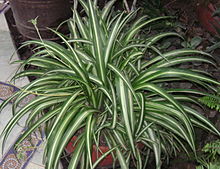- Chlorophytum comosum
-
Chlorophytum comosum 
Chlorophytum comosum 'Vittatum' Scientific classification 
Kingdom: Plantae clade: Angiosperms clade: Monocots Order: Asparagales Family: Asparagaceae Subfamily: Agavoideae Genus: Chlorophytum Species: C. comosum Binomial name Chlorophytum comosum
(Thunb.) Jacques[1]Synonyms - Anthericum comosum Thunb.
- Hartwegia comosa (Thunb.) Nees
Chlorophytum comosum, often called the spider plant, is a herbaceous plant. It is native to tropical and southern Africa, but has become naturalized in other parts of the world, including western Australia.[2] Variegated forms in particular are used as house plants.
Contents
Description
Chlorophytum comosum is a herbaceous perennial, growing to about 60 centimetres (24 in) high. It has fleshy, tuberous roots, about 5–10 centimetres (2–4 in) long. The long narrow leaves reach a length of 20–45 centimetres (8–18 in) and are around 6–25 millimetres (0.2–1.0 in) wide.[3]
Flowers are produced in a long branched inflorescence, which can reach a length of up to 75 centimetres (30 in) and eventually bends downwards. Flowers initially occur in clusters of 1–6 at intervals along the stem (scape) of the inflorescence. Each cluster is at the base of a bract, which ranges from 2–8 centimetres (0.8–3.1 in) in length, becoming smaller towards the end of the inflorescence. Most of the flowers which are produced initially die off, so that the inflorescences are relatively sparsely flowered.[3]
Individual flowers are greenish-white, borne on stalks (pedicels) some 4–8 millimetres (0.2–0.3 in) long. Each flower has six three-veined tepals which are 6–9 millimetres (0.2–0.4 in) long, slightly hooded or boat-shaped at their tips. The stamens consist of a pollen-producing anther about 3.5 millimetres (0.1 in) long with a filament about the same length or slightly longer. The central style is 3–8 millimetres (0.1–0.3 in) long. Seeds are produced in a capsule 3–8 millimetres (0.1–0.3 in) long on stalks (pedicels) which lengthen to up to 12 millimetres (0.5 in).[3]
The inflorescences carry plantlets at the tips of their branches. The stems (scapes) of the inflorescence are called "stolons" in some sources, but this term is more correctly used for stems which do not bear flowers, and have roots at the nodes.[4]
Cultivation
Chlorophytum comosum is a popular houseplant. The species, with all-green leaves, forms only a small proportion of plants sold. More common are two variegated cultivars:[5]
- C. comosum 'Vittatum' has mid-green leaves with a broad central white stripe. It is often sold in hanging baskets to display the plantlets.[5] The stolons are white.
- C.comosum 'Variegatum' has darker green leaves with white margins. It is generally smaller than the previous cultivar.[5] The stolons are green.
Spider plants are easy to grow, being able to thrive in a wide range of conditions. They will tolerate temperatures down to 35 °F (2 °C), but grow best at temperatures between 65 °F (18 °C) and 90 °F (32 °C). Plants can be damaged by high fluoride or boron levels.[5]
Spider plants have also been shown to reduce indoor air pollution.[6]
Botanical history
Chlorophytum comosum was first formally described by the Swedish naturalist Carl Peter Thunberg as Anthericum comosum in the 1794 volume of Prodromus Plantarum Capensium, Thunberg's work on the plants of South Africa.[7][8] It was subsequently moved to a number of different genera, including Phalangium, Caesia, Hartwegia Nees and Hollia, before receiving its current placement in Chlorophytum by Jacques in 1862.[2]
The species has been confused with Chlorophytum capense (L.) Voss by some authors, but this is a different species.[1]
See also
- List of air-filtering plants
References
- ^ a b Chlorophytum comosum information from NPGS/GRIN, www.ars-grin.gov, http://www.ars-grin.gov/cgi-bin/npgs/html/taxon.pl?10301, retrieved 2008-03-17
- ^ a b World Checklist of Selected Plant Families, The Board of Trustees of the Royal Botanic Gardens, Kew, http://apps.kew.org/wcsp/home.do, retrieved 2011-09-26, search for "Chlorophytum comosum"
- ^ a b c McCune, S. & Hardin, D. W. (1994), "Chlorophytum comosum (Thunb.) Jacques", PlantNET - The Plant Information Network System of The Royal Botanic Gardens and Domain Trust, Sydney, Australia: The Royal Botanic Gardens and Domain Trust, http://plantnet.rbgsyd.nsw.gov.au/cgi-bin/NSWfl.pl?page=nswfl&lvl=sp&name=Chlorophytum~comosum, retrieved 2011-09-27
- ^ Hickey, M.; King, C. (2001). The Cambridge Illustrated Glossary of Botanical Terms. Cambridge University Press.
- ^ a b c d Poole, R.T.; Chase, A.R. & Osborne, L.S. (1991), Spider Plant Production Guide (CFREC-Apopka Foliage Plant Research Note RH-91-33), Central Florida Research and Education Center, University of Florida, http://mrec.ifas.ufl.edu/foliage/folnotes/spider.htm, retrieved 2011-09-26
- ^ B. C. Wolverton, Rebecca C. McDonald, and E. A. Watkins, Jr. "Foliage Plants for Removing Indoor Air Pollutants from Energy-efficient Homes". http://ntrs.nasa.gov/search.jsp?R=19860066312. Retrieved 2007-05-03.
- ^ International Organization for Plant Information (IOPI). "Plant Name Search Results" (HTML). International Plant Names Index. http://www.ipni.org/ipni/idPlantNameSearch.do?id=530288-1. Retrieved 26 September 2011.
- ^ Thunberg, Carl Peter. 1794. Prodromus Plantarum Capensium. p. 63.
External links
 Media related to Chlorophytum comosum at Wikimedia CommonsCategories:
Media related to Chlorophytum comosum at Wikimedia CommonsCategories:- Agavoideae
- Flora of South Africa
- House plants
- Plants described in 1794
Wikimedia Foundation. 2010.
